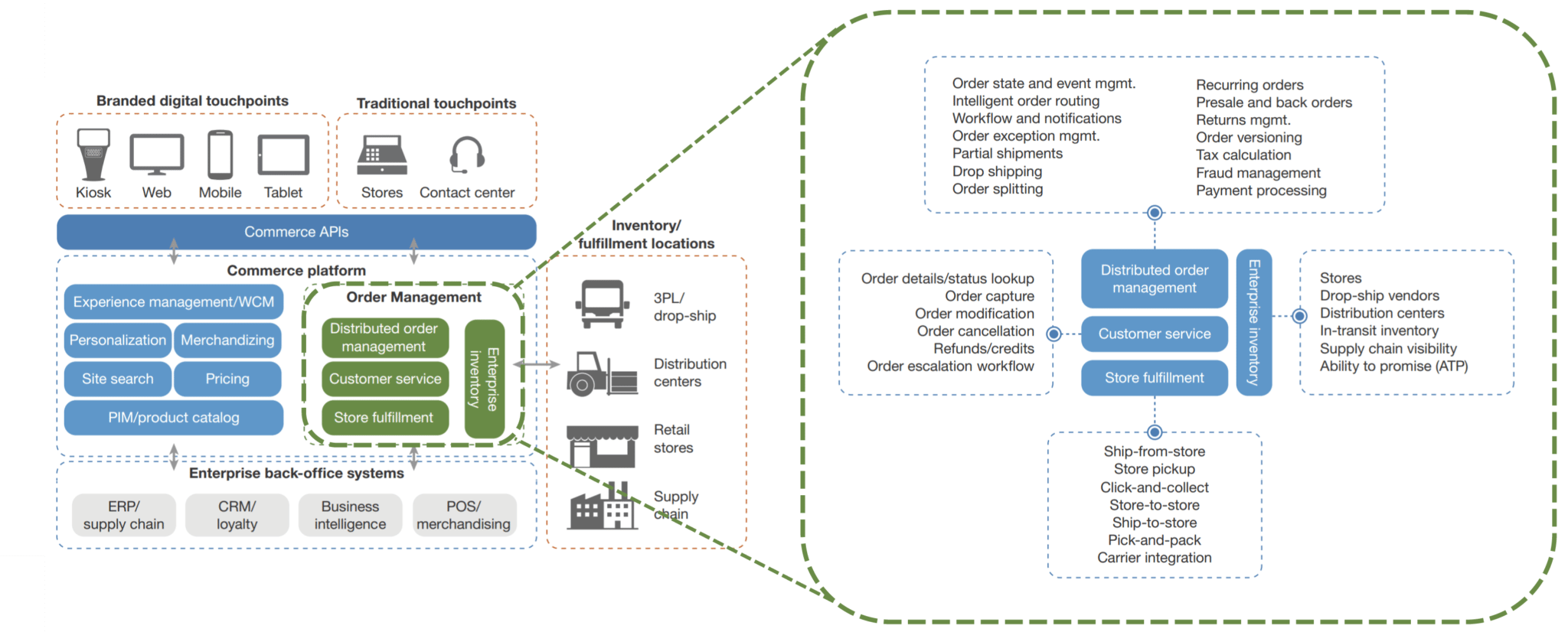What is an Order Management System (OMS)?
An order management system (OMS) is the central nervous system of a modern multichannel retail operation. In a nutshell, an OMS conducts the orchestra of systems that process customer orders, assign them to be fulfilled and shipped, track status throughout the process, and synchronize that information across all of the systems and people that need it.
Sounds easy? When retailers sold only through stores, it was a whole lot easier. As sales channels have proliferated, and customer service expectations have increased, the mission of the OMS has expanded.
To understand the mission of a modern OMS, we need to understand today’s retail challenges.
Retailers must excel in multiple sales channels. Or will lose to those who do.
The pressure to sell through multiple channels is immense. From Amazon Marketplace to brick-and-mortar stores, and from catalog orders to eBay, consumers are driving commerce across more channels and platforms than ever. And customers care. Aberdeen Group Inc. claims that companies with the strongest omnichannel customer engagement strategies retain an average of 89% of their customers, as compared to 33% for companies with weak omnichannel strategies. Macy’s reports that omnichannel shoppers are 8X more valuable than those who shop in a single channel.
Customers expect a consistent and coordinated experience across channels
Customers are growing more accustomed to new services enabled by multiple channels:
-
- I purchased online, and I’d like a telephone rep to change my order.
- I want to make sure the item is in stock before I drive to the store.
- I’m traveling, so I’d like my order delivered after I return, 2 weeks from today.
Traditional order and inventory management software wasn’t designed to work across multiple channels. Customer demands have made change an imperative.
Enter the modern Order Management System (OMS)
Unlike traditional inventory management software, the modern OMS is designed with the end-customers’ experiences in mind. An OMS generates a holistic, centralized, 360 degree view of customer orders and available inventory across all sales channels (stores, marketplaces, ecommerce storefront, distributors), fulfillment centers and customer service channels.
Source: The Forrester Wave™: Omnichannel Order Management, Q3 2014. Click on image to enlarge
A modern OMS unifies critical data to deliver a consistent omnichannel customer experience.
In the examples below, customer service agents have real-time insight into an order’s status, enabling them to deliver a “wow” experience to customers. Managers can accurately report on current stock, and they can more accurately forecast — they can make data-driven decisions, avoid stockouts, and increase inventory turns.
Customer Example
Buy online & pickup in store (BOPIS)
OMS Role
-
- Process order, authorize payment, perform fraud checks
- Confirm inventory in store or in warehouse
- Assign store to fulfill order -or- assign warehouse to ship-to-store
- Update customer, inventory, and order records
- Alert customer when order is ready for pickup.
Customer Example
Buy online & Seek Customer Support
OMS Role
-
- Process order, authorize payment, perform fraud checks
- Intelligently route order to warehouse or store closest to the customer, or with the most days of inventory.
- Provide CSRs with real-time view of all orders, customers and inventory
- Enable CSRs to check order status and modify orders
- Update fulfillment center with new instructions
Customer Example
Check Stock Before Driving to Store
OMS Role
-
- Maintain real-time view of all product inventory across all stores and channels
- Enable online access to sku-level inventory, by store
Why do you need a modern Order Management System?
Today, customers want to buy products , and return them, anywhere and everywhere. Buy online, return in store. They assume that their online orders will be fulfilled and shipped quickly, and exactly as forecasted. They take for granted that the product they want will be in stock. They’re also sharing their experiences more than ever—on review sites, Amazon, and social media. Every bad customer experience can seriously impact your bottom line. The stakes are higher and higher for every single customer interaction.
In a complex, multi-channel business, each of your products passes through many different teams and locations to get to your customer. A great OMS will save you time and hassle every step of the way:
- Stock products – Centralized inventory management means your business is informed with real-time inventory status, ensuring you keep products in stock for web, phone, and brick-and-mortar sales.
- Process orders – Web, phone, mail-order, or in-person sales are all processed by the same system, so nothing slips through the cracks.
- Route and process – Design business rules for intelligent order routing. You can choose to save on shipping costs by choosing the fulfillment center closest to the consumer. Or you can optimize inventory by shipping from an overstocked store.
- Fulfill – Automated tools generate pick lists, packing slips, and shipping labels with a few clicks, so your fulfillment centers can ship faster.
- Deliver – Advanced shipping integration combines your in-house fulfillment and shipping resources with built-in connections to UPS, USPS, FedEx and more. Eliminate the needless lag of exporting and importing order data.
- Return – Orders update in real-time to one central database, so CSRs can modify any order. You can accept returns through any channel, providing consistently great customer service. Behind the scenes, you’ll keep control of your business with advanced workflows and routing for returns.
What are the essential features of a world-class OMS?
Every business is built a bit differently, and a world-class OMS will have additional features and flexibility to meet your precise needs.
- Modern Features – Your OMS must support your omnichannel service aspirations. It’s critical to map your business to OMS features so you can choose an OMS that will meet your needs. Our Order Management System RFP Template can be a great tool to help prioritize and compare features.
- Powerful integration – Your OMS will share information with your ERP, ecommerce storefront (e.g. Shopify, Magento, BigCommerce or others), POS systems, warehouse management system and more. It’s the driving force in unifying your systems. In fact, “underdeveloped APIs” features in our recent white paper as one of the 5 Hidden Costs to Avoid When Buying an Order Management System.
- Cloud-based – Your data and applications are available 24/7 from anywhere, with minimal, if any, tech support. You can learn more about different OMS tech approaches from this whitepaper – Homegrown, On-Premise, or SaaS – Which Order Management System is Best for Me?
- Inventory insights and forecasting – You shouldn’t have to cobble together multiple reports to understand what’s going on with your business. Consistent inventory management across all sales channels ensures that you’re always in stock and able to plan for the future.
- Exceptional customer service – If you ever run into trouble, you need to know that an experienced partner will be there to help.
A modern Order Management System orchestrates your commerce technology and systems to work in concert and deliver stellar omnichannel customer service. Customer satisfaction, share of wallet, and revenue growth all increase while delivering the efficiency and flexibility needed to adapt to ever-evolving commerce channels and customer expectations.


